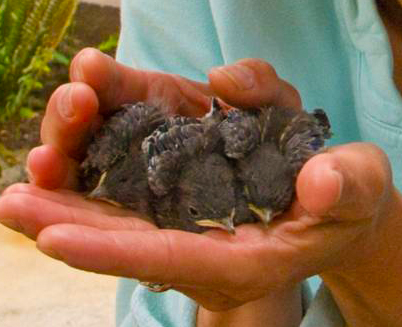Washington Western Bluebird Reintroduction Effort a Success!

(Washington, D.C. , August 11, 2011) A five-year cooperative effort involving several organizations has succeeded in returning the Western Bluebird to Washington’s San Juan Islands. The bird had historically inhabited the islands, but changing land use practices and a paucity of nesting sites meant the species had not nested there for over 40 years.
Over the course of the five-year project, biologists with the Western Bluebird Reintroduction Project captured and translocated 45 breeding pairs of Western Bluebirds from an expanding population at Fort Lewis Military installation, Washington, and another four pairs from the Willamette Valley in Oregon. The birds were kept in aviaries on San Juan Island prior to release to acclimate them to their new surroundings.
One pair of translocated birds nested in the first year, and in each succeeding year the nesting population size has increased. Over the five years, 212 fledglings were produced. Most encouragingly, some of those fledged birds have returned each year and are now part of the breeding population, giving hope that the population will be able to sustain itself into the future.
“It is gratifying to have the hard work of so many people bear fruit with the result that we now see these birds coming back to an area they had once called home. This year, the islands are home to 15 breeding pairs of Western Bluebirds that fledged 74 birds,” said Bob Altman, project leader with American Bird Conservancy. “We are very optimistic about the future of this population,” he said.
The project collaborators included American Bird Conservancy, Fort Lewis Military Installation, Ecostudies Institute, San Juan Preservation Trust, San Juan Islands Audubon Society, Washington Department of Fish and Wildlife, and The Nature Conservancy of Washington.
Thirty birds returned to the San Juan Islands this year. Ten were translocated birds from previous years, 18 were fledged from previous years, and two were of undetermined origin. The 15 pairs of birds built 25 nests, of which 14 were successful.
“This year saw record breaking cool, wet weather through June, meaning everything, including bluebird nesting, was about three to four weeks behind. This resulted in reduced productivity from the previous year. House Sparrows also caused three or four nesting failures, which is something we may need to address in coming years,” Altman said.
The project is now moving into a two-year monitoring phase to determine the stability and growth of the population, and the need for future population management.
“We are very pleased to have achieved our goal of establishing a breeding population, however, 15 pairs is by no means a large enough population to be considered secure, so we are exploring ways to enhance it beyond the initial five-year period,” he said.
One potential enhancement is Western Bluebird translocations in nearby British Columbia that may be starting next year. The San Juan Islands are only 20-25 miles as the bluebird flies from the proposed release site on Salt Spring Island, British Columbia, and it is likely that the continuation of translocations in British Columbia will help to sustain the San Juan Islands population in the future.
In tandem with the translocations, project partners also are working to conserve the oak-prairie ecosystem that the birds depend on. Toward that end, the San Juan Preservation Trust made a key prairie-oak land acquisition – 120 acres in the center of the San Juan Valley- which hosts two nesting pairs of bluebirds and is a primary location at which flocks of bluebirds congregate during the post-breeding season. In addition, approximately 600 nest boxes have been put up on the islands to provide additional nesting opportunities for the returning birds.
Altman said that “the project would not have been possible without the help of numerous people on the San Juan Islands, who hosted aviaries and nest boxes on their properties, helped construct nest boxes and move aviaries, provided materials and project equipment, and helped monitor nest boxes and look for released birds. Further, he added “I don’t know of any other bird reintroduction project that relied completely on so many private landowners”.
